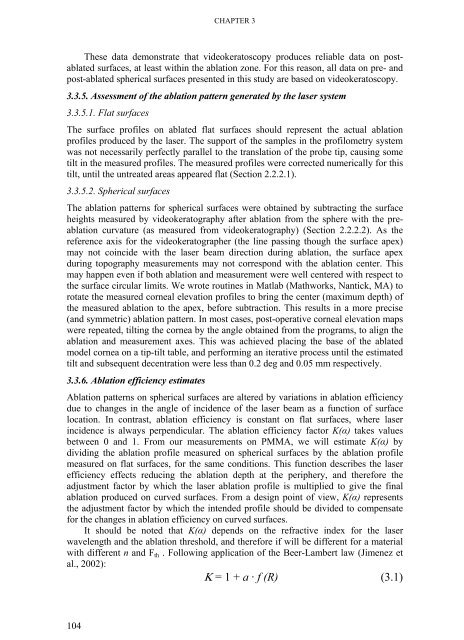Low_resolution_Thesis_CDD_221009_public - Visual Optics and ...
Low_resolution_Thesis_CDD_221009_public - Visual Optics and ...
Low_resolution_Thesis_CDD_221009_public - Visual Optics and ...
You also want an ePaper? Increase the reach of your titles
YUMPU automatically turns print PDFs into web optimized ePapers that Google loves.
CHAPTER 3<br />
These data demonstrate that videokeratoscopy produces reliable data on postablated<br />
surfaces, at least within the ablation zone. For this reason, all data on pre- <strong>and</strong><br />
post-ablated spherical surfaces presented in this study are based on videokeratoscopy.<br />
3.3.5. Assessment of the ablation pattern generated by the laser system<br />
3.3.5.1. Flat surfaces<br />
The surface profiles on ablated flat surfaces should represent the actual ablation<br />
profiles produced by the laser. The support of the samples in the profilometry system<br />
was not necessarily perfectly parallel to the translation of the probe tip, causing some<br />
tilt in the measured profiles. The measured profiles were corrected numerically for this<br />
tilt, until the untreated areas appeared flat (Section 2.2.2.1).<br />
3.3.5.2. Spherical surfaces<br />
The ablation patterns for spherical surfaces were obtained by subtracting the surface<br />
heights measured by videokeratography after ablation from the sphere with the preablation<br />
curvature (as measured from videokeratography) (Section 2.2.2.2). As the<br />
reference axis for the videokeratographer (the line passing though the surface apex)<br />
may not coincide with the laser beam direction during ablation, the surface apex<br />
during topography measurements may not correspond with the ablation center. This<br />
may happen even if both ablation <strong>and</strong> measurement were well centered with respect to<br />
the surface circular limits. We wrote routines in Matlab (Mathworks, Nantick, MA) to<br />
rotate the measured corneal elevation profiles to bring the center (maximum depth) of<br />
the measured ablation to the apex, before subtraction. This results in a more precise<br />
(<strong>and</strong> symmetric) ablation pattern. In most cases, post-operative corneal elevation maps<br />
were repeated, tilting the cornea by the angle obtained from the programs, to align the<br />
ablation <strong>and</strong> measurement axes. This was achieved placing the base of the ablated<br />
model cornea on a tip-tilt table, <strong>and</strong> performing an iterative process until the estimated<br />
tilt <strong>and</strong> subsequent decentration were less than 0.2 deg <strong>and</strong> 0.05 mm respectively.<br />
3.3.6. Ablation efficiency estimates<br />
Ablation patterns on spherical surfaces are altered by variations in ablation efficiency<br />
due to changes in the angle of incidence of the laser beam as a function of surface<br />
location. In contrast, ablation efficiency is constant on flat surfaces, where laser<br />
incidence is always perpendicular. The ablation efficiency factor K() takes values<br />
between 0 <strong>and</strong> 1. From our measurements on PMMA, we will estimate K() by<br />
dividing the ablation profile measured on spherical surfaces by the ablation profile<br />
measured on flat surfaces, for the same conditions. This function describes the laser<br />
efficiency effects reducing the ablation depth at the periphery, <strong>and</strong> therefore the<br />
adjustment factor by which the laser ablation profile is multiplied to give the final<br />
ablation produced on curved surfaces. From a design point of view, K() represents<br />
the adjustment factor by which the intended profile should be divided to compensate<br />
for the changes in ablation efficiency on curved surfaces.<br />
It should be noted that K() depends on the refractive index for the laser<br />
wavelength <strong>and</strong> the ablation threshold, <strong>and</strong> therefore if will be different for a material<br />
with different n <strong>and</strong> F th . Following application of the Beer-Lambert law (Jimenez et<br />
al., 2002):<br />
= 1 + a · f (R) (3.1)<br />
104











